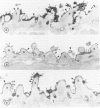Abstract
It was previously shown by the authors that the binding of human low-density lipoprotein (LDL) to the surface of schistosomula inhibits the binding of human anti-schistosomal antibodies and is inhibited by suramin. Here, three questions were considered. 1) Are LDLs bound to schistosomula displaced from the membrane by polyanions? 2) Does bound LDL mask or hide antigens recognized by human anti-schistosomal antibodies? 3) Is LDL, binding capability present when the larvae enter the blood stream? The first question was tested by measuring the percentage of the schistosomular surface membrane covered by LDL after exposure to LDL with or without dextran sulfate or suramin. The bound LDL was visualized with polyclonal goat anti-human apolipoprotein B (anti-apo B) antibodies and peroxidase-conjugated secondary antibodies. After overnight culture in 20 micrograms/300 microliters LDL, 84.0% +/- 0.3% of the parasite surface was covered by LDL reaction product. When the polyanions suramin or dextran sulfate were added to the cultures for 30 minutes, only 59.7% +/- 4.9% of the surface was covered by reaction product, demonstrating that the LDL was partially displaced from the membrane by these compounds. The second question was tested by measuring the binding of human and mouse monoclonal anti-schistosomal antibodies before and after exposure to LDL, with or without partial removal of the bound LDL by suramin. LDL partially inhibited antibody binding in a reversible fashion. The LDL clearly masked parasite antigens, most probably by steric hindrance. However, there may be competitive inhibition of antibody binding by the LDL as well, because human anti-schistosomal antibodies inhibited LDL binding to worms and both human anti-schistosomal antibody and LDL binding to schistosomula were inhibited by suramin. Finally, the third question was tested by quantitative immunofluorescence. The LDL binding capability persisted and nearly doubled by 72 hours after transformation from cercariae. These experiments demonstrated that LDL bound to the surface of schistosomula through the time they enter the blood stream. LDL bound to the parasite surface may help the parasite to evade antibody-dependent cytotoxic reactions by masking parasite antigens.
Full text
PDF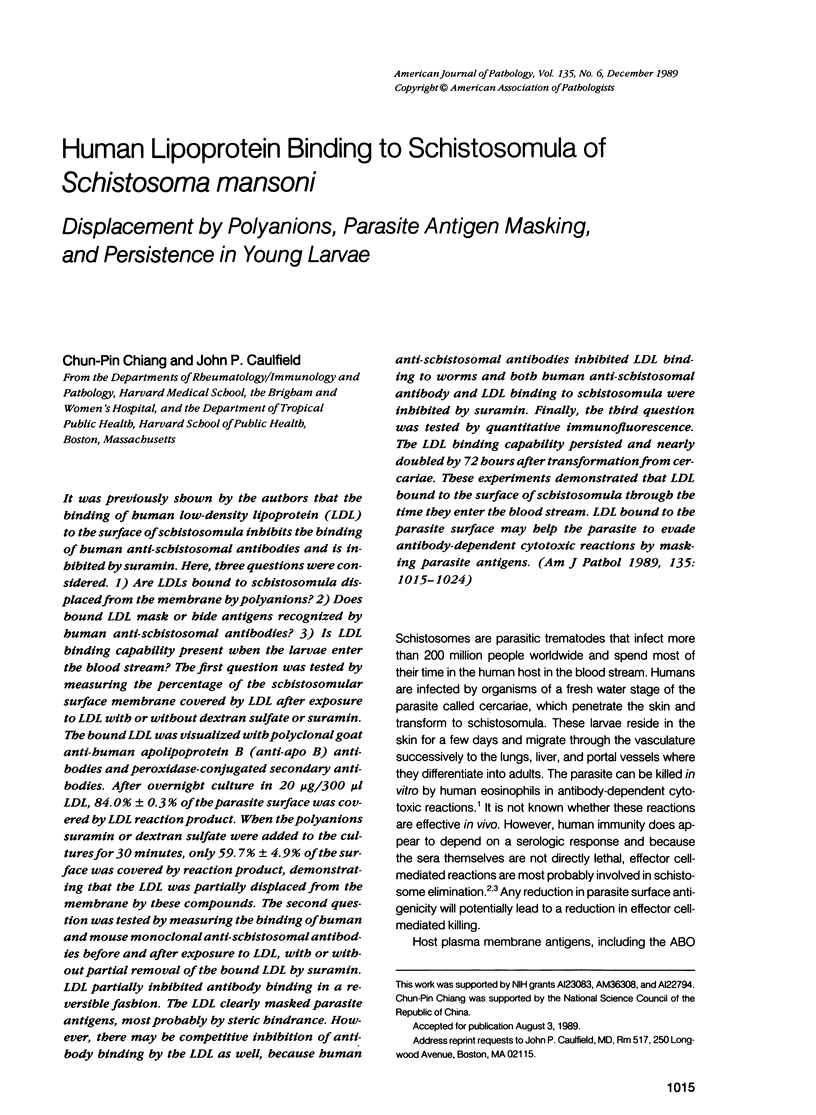
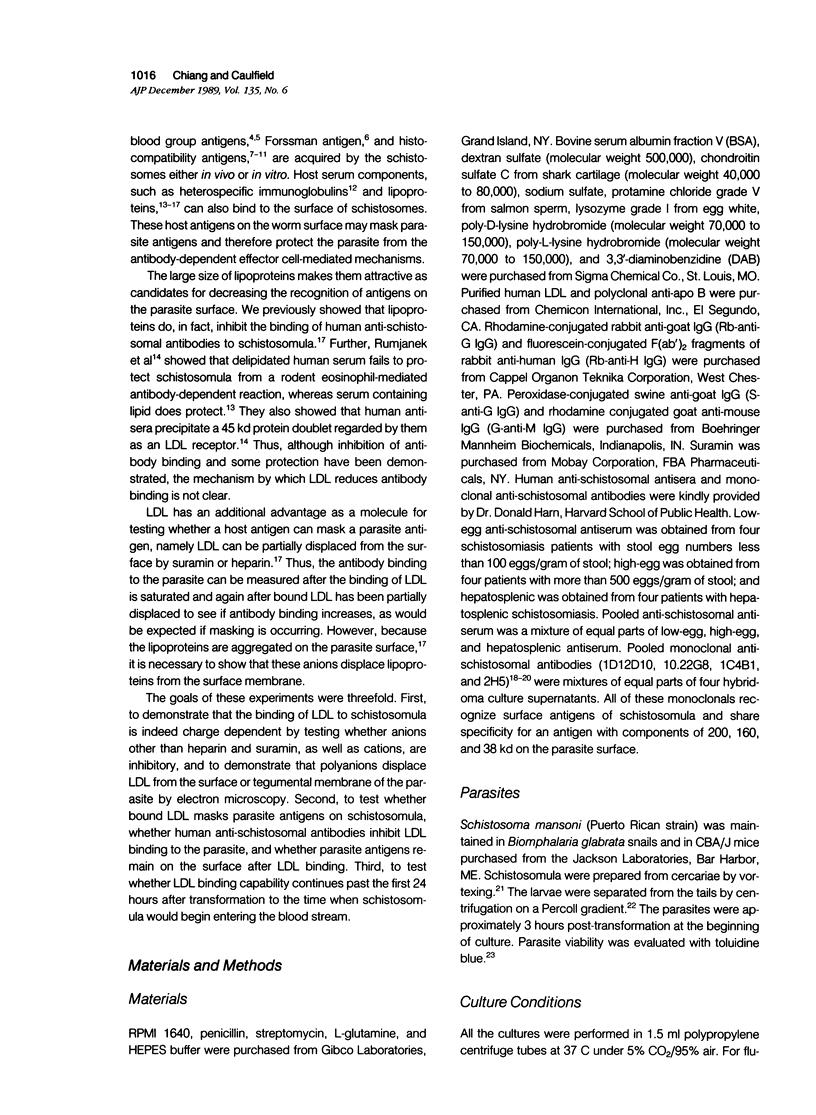

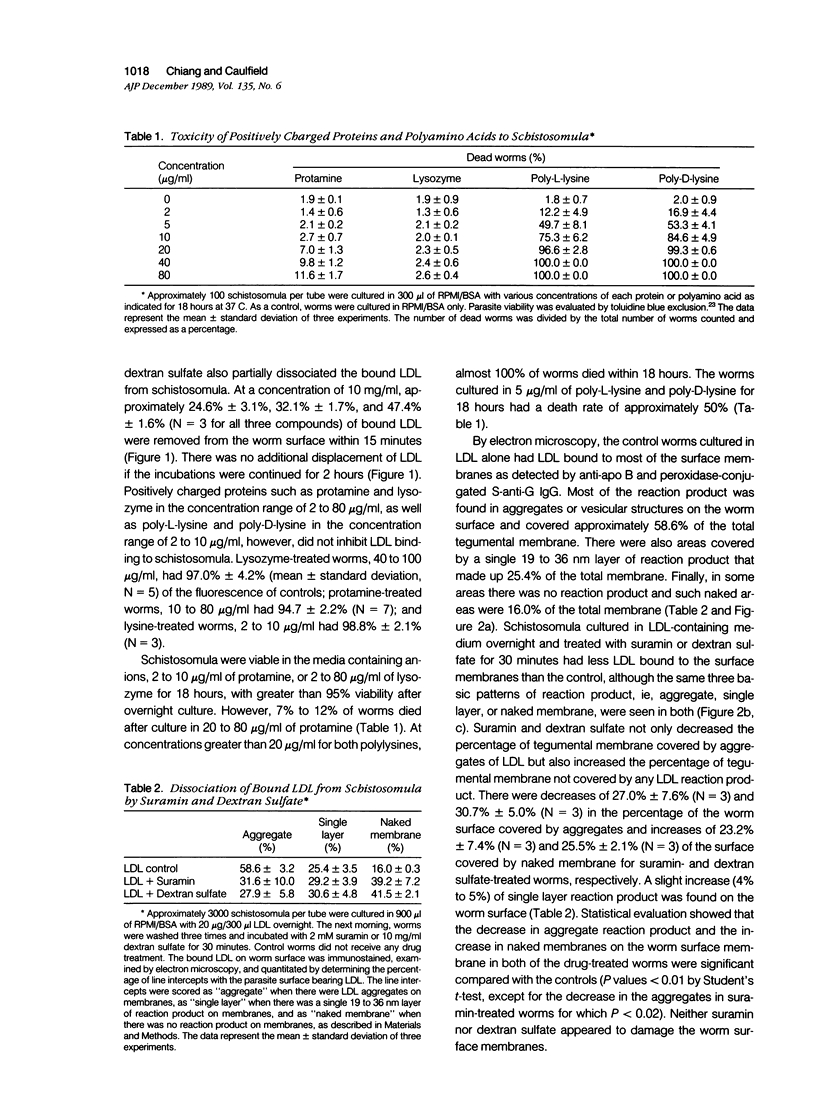
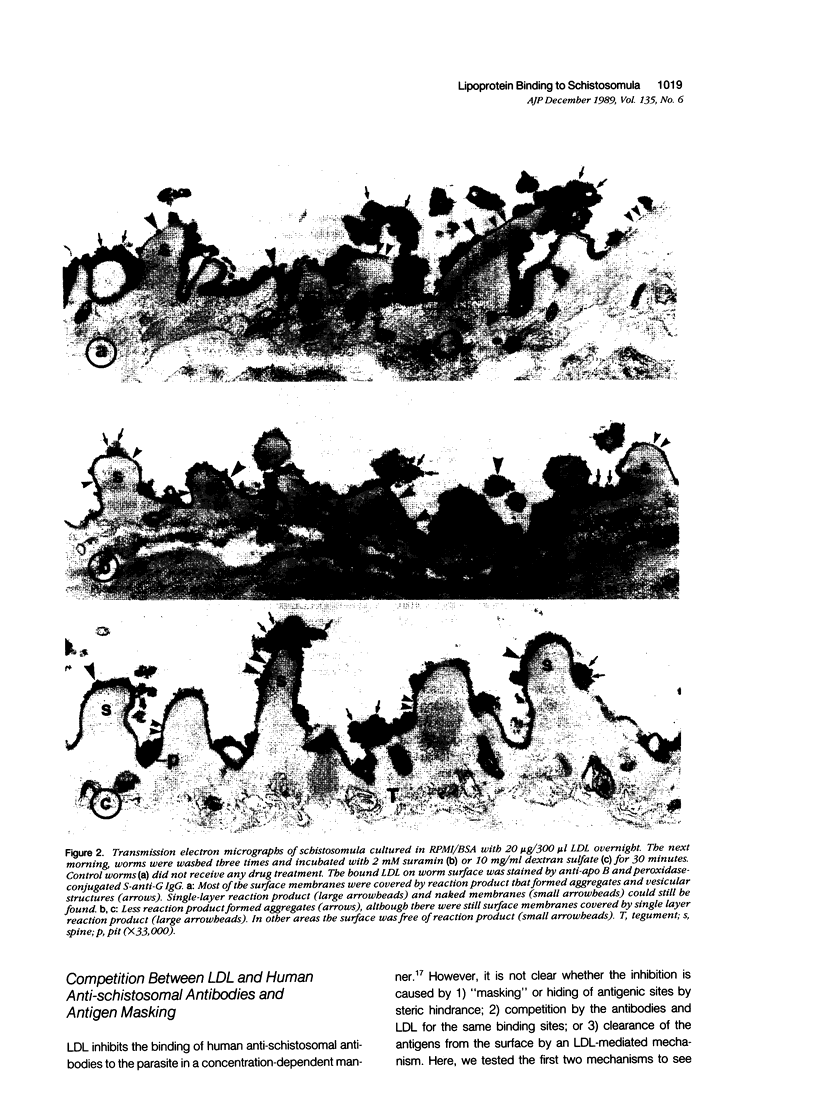

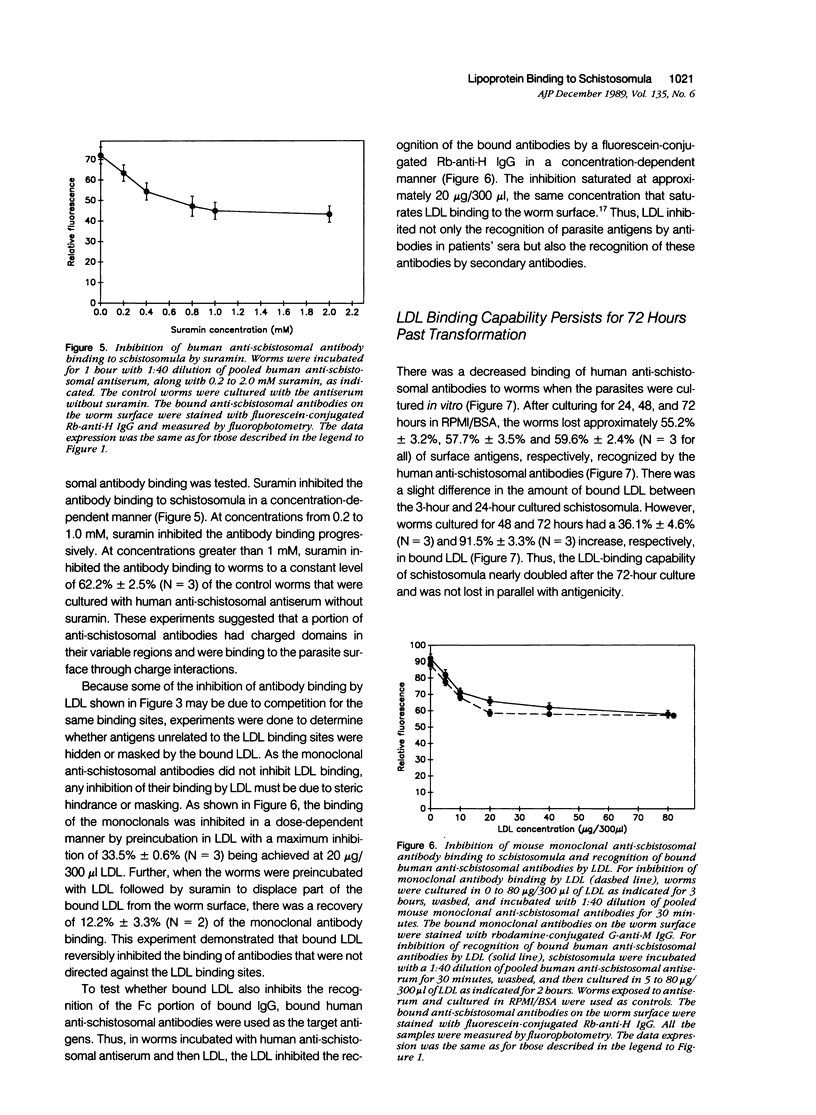
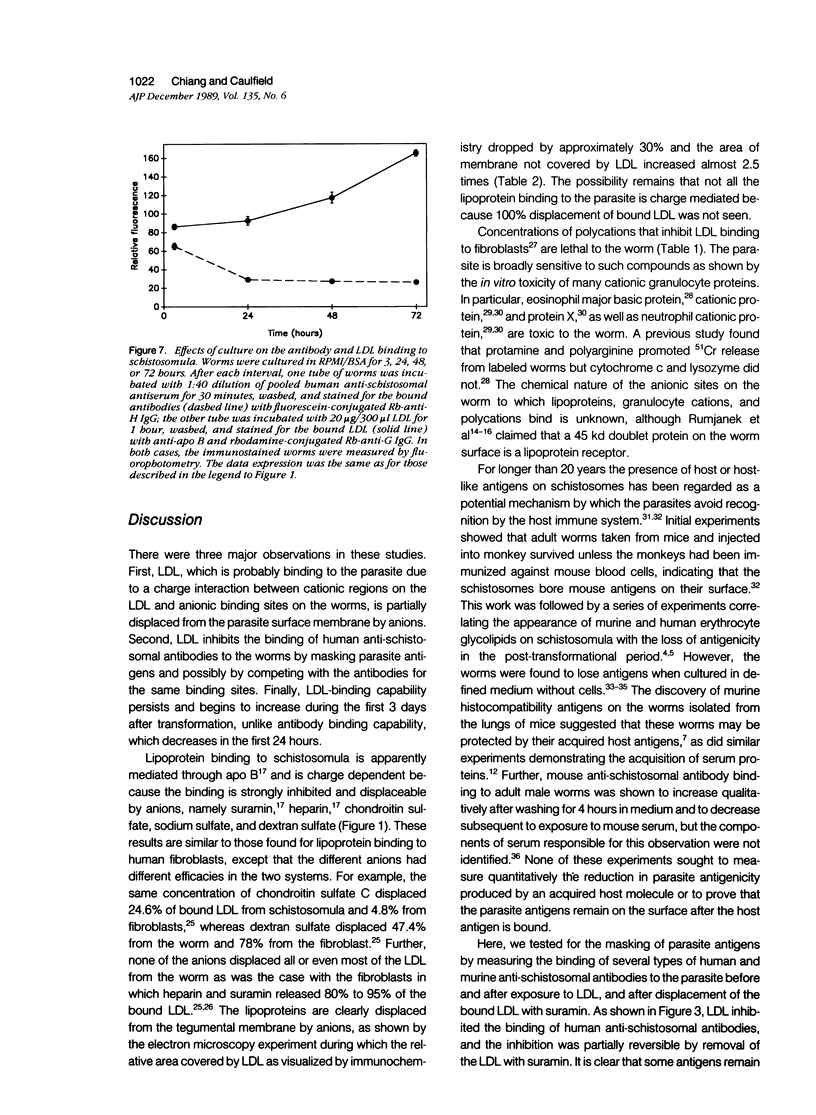
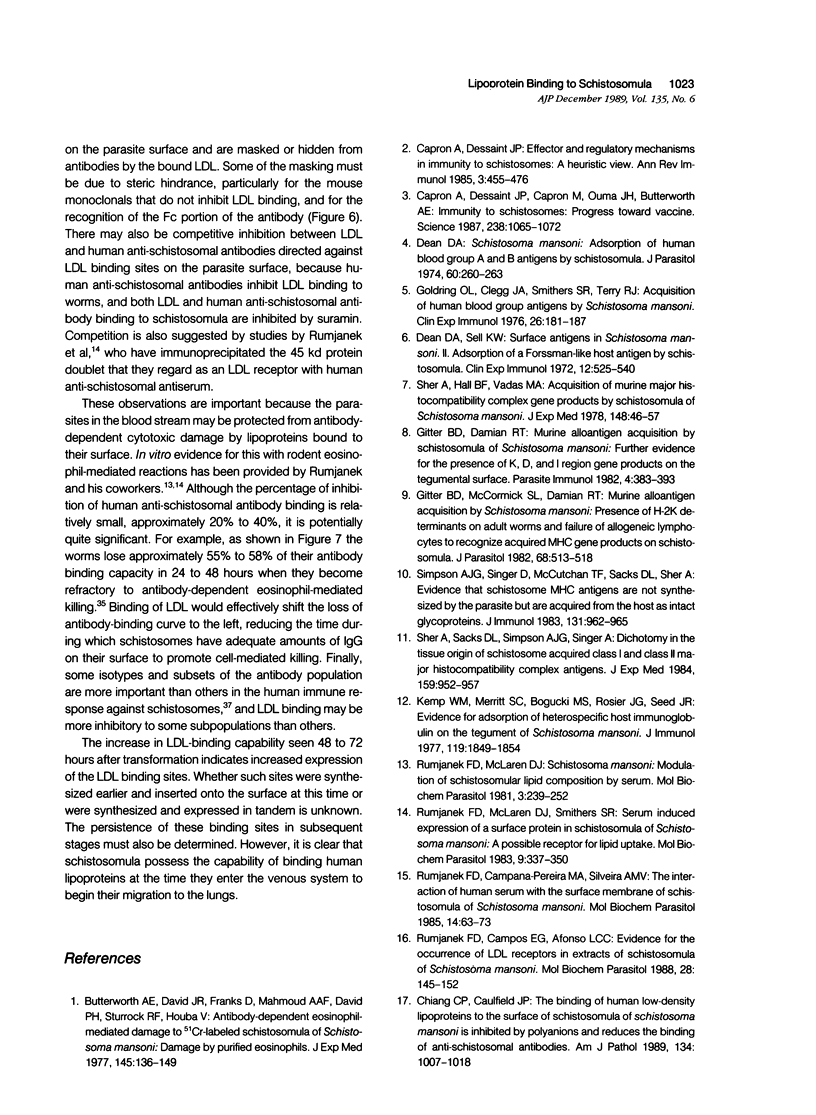
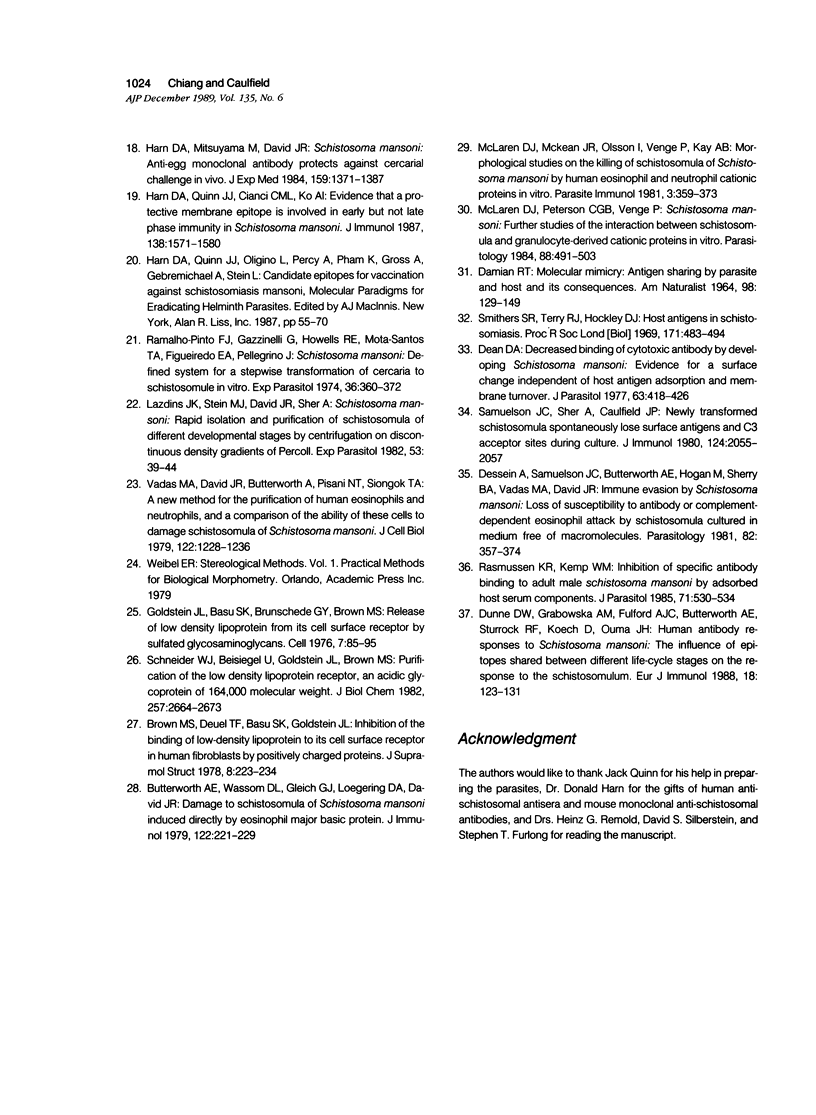
Images in this article
Selected References
These references are in PubMed. This may not be the complete list of references from this article.
- Brown M. S., Deuel T. F., Basu S. K., Goldstein J. L. Inhibition of the binding of low-density lipoprotein to its cell surface receptor in human fibroblasts by positively charged proteins. J Supramol Struct. 1978;8(3):223–234. doi: 10.1002/jss.400080302. [DOI] [PubMed] [Google Scholar]
- Butterworth A. E., David J. R., Franks D., Mahmoud A. A., David P. H., Sturrock R. F., Houba V. Antibody-dependent eosinophil-mediated damage to 51Cr-labeled schistosomula of Schistosoma mansoni: damage by purieid eosinophils. J Exp Med. 1977 Jan 1;145(1):136–150. doi: 10.1084/jem.145.1.136. [DOI] [PMC free article] [PubMed] [Google Scholar]
- Butterworth A. E., Wassom D. L., Gleich G. J., Loegering D. A., David J. R. Damage to schistosomula of Schistosoma mansoni induced directly by eosinophil major basic protein. J Immunol. 1979 Jan;122(1):221–229. [PubMed] [Google Scholar]
- Capron A., Dessaint J. P., Capron M., Ouma J. H., Butterworth A. E. Immunity to schistosomes: progress toward vaccine. Science. 1987 Nov 20;238(4830):1065–1072. doi: 10.1126/science.3317823. [DOI] [PubMed] [Google Scholar]
- Capron A., Dessaint J. P. Effector and regulatory mechanisms in immunity to schistosomes: a heuristic view. Annu Rev Immunol. 1985;3:455–476. doi: 10.1146/annurev.iy.03.040185.002323. [DOI] [PubMed] [Google Scholar]
- Chiang C. P., Caulfield J. P. The binding of human low-density lipoproteins to the surface of schistosomula of Schistosoma mansoni is inhibited by polyanions and reduces the binding of anti-schistosomal antibodies. Am J Pathol. 1989 May;134(5):1007–1018. [PMC free article] [PubMed] [Google Scholar]
- Dean D. A. Decreased binding of cytotoxic antibody by developing Schistosoma mansoni. Evidence for a surface change independent of host antigen adsorption and membrane turnover. J Parasitol. 1977 Jun;63(3):418–426. [PubMed] [Google Scholar]
- Dean D. A. Schistosoma mansoni: adsorption of human blood group A and B antigens by schistosomula. J Parasitol. 1974 Apr;60(2):260–263. [PubMed] [Google Scholar]
- Dean D. A., Sell K. W. Surface antigens on Schistosoma mansoni. II. Adsorption of a Forssman-like host antigen by schistosomula. Clin Exp Immunol. 1972 Dec;12(4):525–540. [PMC free article] [PubMed] [Google Scholar]
- Dessein A., Samuelson J. C., Butterworth A. E., Hogan M., Sherry B. A., Vadas M. A., David J. R. Immune evasion by Schistosoma mansoni: loss of susceptibility to antibody or complement-dependent eosinophil attack by schistosomula cultured in medium free of macromolecules. Parasitology. 1981 Jun;82(Pt 3):357–374. doi: 10.1017/s0031182000066890. [DOI] [PubMed] [Google Scholar]
- Dunne D. W., Grabowska A. M., Fulford A. J., Butterworth A. E., Sturrock R. F., Koech D., Ouma J. H. Human antibody responses to Schistosoma mansoni: the influence of epitopes shared between different life-cycle stages on the response to the schistosomulum. Eur J Immunol. 1988 Jan;18(1):123–131. doi: 10.1002/eji.1830180119. [DOI] [PubMed] [Google Scholar]
- Gitter B. D., Damian R. T. Murine alloantigen acquisition by schistosomula of Schistosoma mansoni: further evidence for the presence of K, D, and I region gene products on the tegumental surface. Parasite Immunol. 1982 Nov;4(6):383–393. doi: 10.1111/j.1365-3024.1982.tb00450.x. [DOI] [PubMed] [Google Scholar]
- Gitter B. D., McCormick S. L., Damian R. T. Murine alloantigen acquisition by Schistosoma mansoni: presence of H-2K determinants on adult worms and failure of allogeneic lymphocytes to recognize acquired MHC gene products on schistosomula. J Parasitol. 1982 Aug;68(4):513–518. [PubMed] [Google Scholar]
- Goldring O. L., Clegg J. A., Smithers S. R., Terry R. J. Acquisition of human blood group antigens by Schistosoma mansoni. Clin Exp Immunol. 1976 Oct;26(1):181–187. [PMC free article] [PubMed] [Google Scholar]
- Goldstein J. L., Basu S. K., Brunschede G. Y., Brown M. S. Release of low density lipoprotein from its cell surface receptor by sulfated glycosaminoglycans. Cell. 1976 Jan;7(1):85–95. doi: 10.1016/0092-8674(76)90258-0. [DOI] [PubMed] [Google Scholar]
- Harn D. A., Mitsuyama M., David J. R. Schistosoma mansoni. Anti-egg monoclonal antibodies protect against cercarial challenge in vivo. J Exp Med. 1984 May 1;159(5):1371–1387. doi: 10.1084/jem.159.5.1371. [DOI] [PMC free article] [PubMed] [Google Scholar]
- Harn D. A., Quinn J. J., Cianci C. M., Ko A. I. Evidence that a protective membrane epitope is involved in early but not late phase immunity in Schistosoma mansoni. J Immunol. 1987 Mar 1;138(5):1571–1580. [PubMed] [Google Scholar]
- Kemp W. M., Merritt S. C., Bogucki M. S., Rosier J. G., Seed J. R. Evidence for adsorption of heterospecific host immunoglobulin on the tegument of Schistosoma mansoni. J Immunol. 1977 Nov;119(5):1849–1854. [PubMed] [Google Scholar]
- Lazdins J. K., Stein M. J., David J. R., Sher A. Schistosoma mansoni: rapid isolation and purification of schistosomula of different developmental stages by centrifugation on discontinuous density gradients of Percoll. Exp Parasitol. 1982 Feb;53(1):39–44. doi: 10.1016/0014-4894(82)90090-x. [DOI] [PubMed] [Google Scholar]
- McLaren D. J., McKean J. R., Olsson I., Venges P., Kay A. B. Morphological studies on the killing of schistosomula of Schistosoma mansoni by human eosinophil and neutrophil cationic proteins in vitro. Parasite Immunol. 1981 Winter;3(4):359–373. doi: 10.1111/j.1365-3024.1981.tb00414.x. [DOI] [PubMed] [Google Scholar]
- McLaren D. J., Peterson C. G., Venge P. Schistosoma mansoni: further studies of the interaction between schistosomula and granulocyte-derived cationic proteins in vitro. Parasitology. 1984 Jun;88(Pt 3):491–503. doi: 10.1017/s0031182000054755. [DOI] [PubMed] [Google Scholar]
- Ramalho-Pinto F. J., Gazzinelli G., Howells R. E., Mota-Santos T. A., Figueiredo E. A., Pellegrino J. Schistosoma mansoni: defined system for stepwise transformation of cercaria to schistosomule in vitro. Exp Parasitol. 1974 Dec;36(3):360–372. doi: 10.1016/0014-4894(74)90076-9. [DOI] [PubMed] [Google Scholar]
- Rasmussen K. R., Kemp W. M. Inhibition of specific antibody binding to adult male Schistosoma mansoni by adsorbed host serum components. J Parasitol. 1985 Oct;71(5):530–534. [PubMed] [Google Scholar]
- Rumjanek F. D., Campos E. G., Afonso L. C. Evidence for the occurrence of LDL receptors in extracts of schistosomula of Schistosoma mansoni. Mol Biochem Parasitol. 1988 Mar;28(2):145–152. doi: 10.1016/0166-6851(88)90062-x. [DOI] [PubMed] [Google Scholar]
- Rumjanek F. D., McLaren D. J. Schistosoma mansoni: modulation of schistosomular lipid composition by serum. Mol Biochem Parasitol. 1981 Aug;3(4):239–252. doi: 10.1016/0166-6851(81)90055-4. [DOI] [PubMed] [Google Scholar]
- Rumjanek F. D., McLaren D. J., Smithers S. R. Serum-induced expression of a surface protein in schistosomula of Schistosoma mansoni: a possible receptor for lipid uptake. Mol Biochem Parasitol. 1983 Dec;9(4):337–350. doi: 10.1016/0166-6851(83)90090-7. [DOI] [PubMed] [Google Scholar]
- Rumjanek F. D., Pereira M. A., Silveira A. M. The interaction of human serum with the surface membrane of schistosomula of Schistosoma mansoni. Mol Biochem Parasitol. 1985 Jan;14(1):63–73. doi: 10.1016/0166-6851(85)90106-9. [DOI] [PubMed] [Google Scholar]
- Samuelson J. C., Sher A., Caulfield J. P. Newly transformed schistosomula spontaneously lose surface antigens and C3 acceptor sites during culture. J Immunol. 1980 Apr;124(4):2055–2057. [PubMed] [Google Scholar]
- Schneider W. J., Beisiegel U., Goldstein J. L., Brown M. S. Purification of the low density lipoprotein receptor, an acidic glycoprotein of 164,000 molecular weight. J Biol Chem. 1982 Mar 10;257(5):2664–2673. [PubMed] [Google Scholar]
- Sher A., Hall B. F., Vadas M. A. Acquisition of murine major histocompatibility complex gene products by schistosomula of Schistosoma mansoni. J Exp Med. 1978 Jul 1;148(1):46–57. doi: 10.1084/jem.148.1.46. [DOI] [PMC free article] [PubMed] [Google Scholar]
- Sher A., Sacks D. L., Simpson A. J., Singer A. Dichotomy in the tissue origin of schistosome acquired class I and class II major histocompatibility complex antigens. J Exp Med. 1984 Mar 1;159(3):952–957. doi: 10.1084/jem.159.3.952. [DOI] [PMC free article] [PubMed] [Google Scholar]
- Simpson A. J., Singer D., McCutchan T. F., Sacks D. L., Sher A. Evidence that schistosome MHC antigens are not synthesized by the parasite but are acquired from the host as intact glycoproteins. J Immunol. 1983 Aug;131(2):962–965. [PubMed] [Google Scholar]
- Smithers S. R., Terry R. J., Hockley D. J. Host antigens in schistosomiasis. Proc R Soc Lond B Biol Sci. 1969 Feb 25;171(1025):483–494. doi: 10.1098/rspb.1969.0007. [DOI] [PubMed] [Google Scholar]
- Vadas M. A., David J. R., Butterworth A., Pisani N. T., Siongok T. A. A new method for the purification of human eosinophils and neutrophils, and a comparison of the ability of these cells to damage schistosomula of Schistosoma mansoni. J Immunol. 1979 Apr;122(4):1228–1236. [PubMed] [Google Scholar]



